By: Tommy “T-Rod” Rodriguez
Plot: the events of a story, how they play out, the introduction to resolution. In the medium of manga/anime, plot is one of the most important aspects of storytelling…and the easiest to mess up. Serialized fiction can be infamous for having little to no planning or foresight involved, sometimes leading to random story events, retcons, and a lack of consequences. The very concept of an “arc” in the medium of animanga is to have a smaller scale story acting as a piece of the larger puzzle. The Chimera Ant Arc is one of many story arcs of Hunter X Hunter. It’s the next stop protagonists Gon and Killua take on their adventure together, but this stop is longer than almost every other arc in Hunter X Hunter combined, with a narrative that is antithetical to typical shounen stories.
The use of subversion and misdirection in the Chimera Ant Arc makes for a great plot, this is true. But by slightly tweaking the plot events and payoffs viewers expect to see in a shounen battle series, author Yoshihiro Togashi makes the plot hit your very core. The difference between plots that genuinely go off the rails in a bad way, ala the Buu Saga of DBZ, versus what happens here, is execution and reader expectation. For a lot of viewers, this arc is too long or misguided. Looking at it on a deeper level, however, I think the sequencing of this arc is brilliant in showing how a story can yield atypical results and still succeed at tugging at your heartstrings. Or make you feel existential dread.
So, let’s get into why Yoshihiro Togashi is great at deconstructing the typical animanga storyline. This is a long one, so I will be going in the same order as the plot, beginning with Gon and Killua finding Kite and going forward.
The False Start to End All False Starts
Fans of Hunter X Hunter know that when it comes to plot swerves, the series is unrivaled. Most of the time, characters will seemingly achieve their goals or narrowly miss them, only for the plot to pick up somewhere else entirely. A perfect example of this can be found in the underrated Gon and Hisoka fight early in the show: after Gon lost, I expected a salty rematch to come soon.
As of yet though, they still haven’t had that rematch. For the majority of HxH, Togashi likes to focus on Gon’s journey to find his father. If something isn’t relevant, it’ll most likely be swept away in a nonchalant manner. The beginning of this storyline almost completely stops Gon’s search for his father, allowing the setting to breathe and develop its own isolated story while still leaving room for him to grow. Along with Killua, our spiky-haired protagonist thinks he finally found his dad, only to discover Kite. With no clues left to go off, the duo decide to stick around with him on a nature expedition: whether it’s as a potential route to his father or to just enjoy Kite’s presence is left ambiguous, but the relationship with this character is one of Gon’s most important.
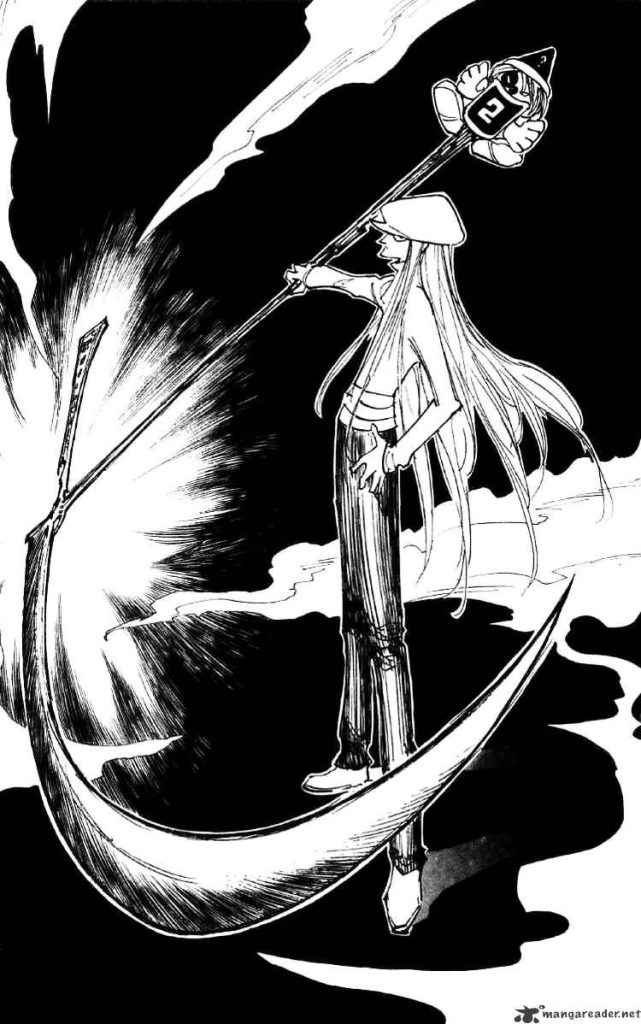
The opening moments of the Chimera Ant Arc are brilliant in getting you into a false sense of security. As the existence of the carnivorous Chimera Ants is discovered, Kite, Gon and Killua answer the call to stop this horror movie-type threat. We’re shown panels and events that build anticipation for a big battle, with the trio exploring more and more of the Ants’ territory: we get some amazing displays of combat and the boys’ overconfidence as they steamroll through powerful opponents. Kite in particular shines: his kindness and unique abilities show him as a likable mentor figure for the boys, as well as a formidable fighter with a heart of gold.
The reason I call this whole section of story a false start is for a few reasons. Automatically, a typical shounen reader can see this is a typical way to start an arc: we find a new character who is somehow related to our main hero, discover a new villain to take down, have some cool fight scenes and eventually meet the big bad. Prior to this point, however, HxH hadn’t been typical at all, so a certain unease began to build within me on first viewing. Why is everything so much simpler now?
The other reason I consider it a false start is because of the “villains” in question, the Ants. At first, they seem very one-note, killing civilians to help feed their Queen so she may give birth to a King. As more episodes/chapters pile on however, we realize that the Ants aren’t just intelligent…they have feelings and goals. The camaraderie between them is fascinating, especially as they develop speech and explore different strategies to feed the Queen. Some are overly aggressive, some protective…and things only get more complicated when you realize that they take on the characteristics of the humans and animals that the Queen ate to birth them. Some are likable. Again, there’s hints that things are going to go south fast…and this dramatic irony plays exactly into the arc’s strengths. The Ants are far, far more complicated than they appear to be, and their focus early on makes the reader recognize that.
Unlike the reader, the heroes have no idea how dangerous things will get, leading to the first BIG twist…Kite’s dismemberment and Gon and Killua’s retreat.
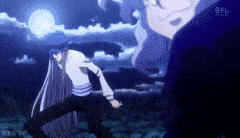
Shit Goes South
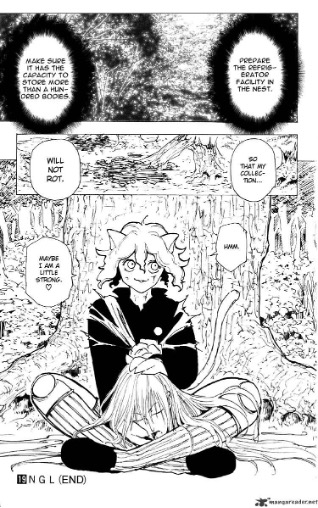
The brilliance in the Chimera Ant storyline comes from how quickly we realize Gon and Killua do not stack up to this monumental task. Powerless to stop Pitou, one of the Ant King’s Royal Guards, all sense of normalcy is thrown out the window. With the ability to learn Nen (HxH’s power system) these already strong creatures now possess the ability to kill some of the most impressive characters in the story…characters which Gon and Killua do not even come close to comparing to. After the retreat, the arc takes a slight break in progression, focusing instead on the interesting developments between our protagonists and antagonists: over time, Gon and Killua train to improve their abilities. More Ants on the same level as Pitou are birthed, a new set of elite Hunters step in to gauge the situation and plan stuff out.
Not everything is so easy, though.
While some consider this section of the story to be boring, I honestly think that it’s probably the most important in setting up the arc’s later devastation. Security settles in at first when we are hit with three key developments:
- The boys are getting stronger
- We have an all-star cast of Hunters to combat the Ants
- It appears that the Ants numbers are getting whittled down
A mid-arc training session is a standard shounen trope, but here we get one that is the most intense our characters have faced, setting up expectations that they’ll be ready to take on the Ants soon. The first red flag appears, however, when the boys fail their training. Despite the monumental effort they display over numerous chapters/episodes, they simply aren’t strong enough to immediately participate in the Ant mission, leaving them stranded. Again, Togashi robs viewers of seeing Gon and Killua get satisfying momentum in the story.
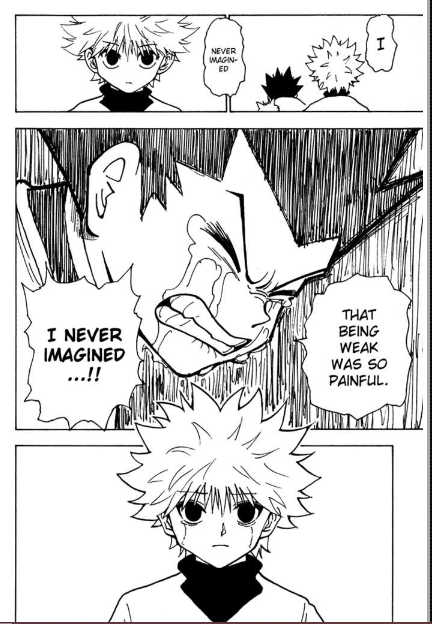
Focusing on the efforts of our other Hunters, it seems like they’re able to easily dispose of the fodder that the Ants throw at them, building confidence in the reader that, again, our heroes might be able to win. With some great paneling and dialogue, the new Hunters are outright glamorized as they seemingly clean up the Ants, until one Ant defecting from the rest of the group calls a truce to talk to Netero, Knov and Morel, dropping intel that pretty much destroys any confidence we may have.
Even the best of the Hunters don’t stand a chance to the Ant King and his Royal Guard.
In panels and scenes interspersed between those of our heroes, the viewers sees that the Ant problem has only gotten worse. Not only have two more Royal guards been born, but the most powerful being on the planet, their King, has been born, killing the Queen ant in a spectacularly gruesome faction. Now the number of worldwide threats has multiplied, and what’s even worse, all of the solutions and planning our heroes have made along this stretch may not mean anything when facing such raw power.
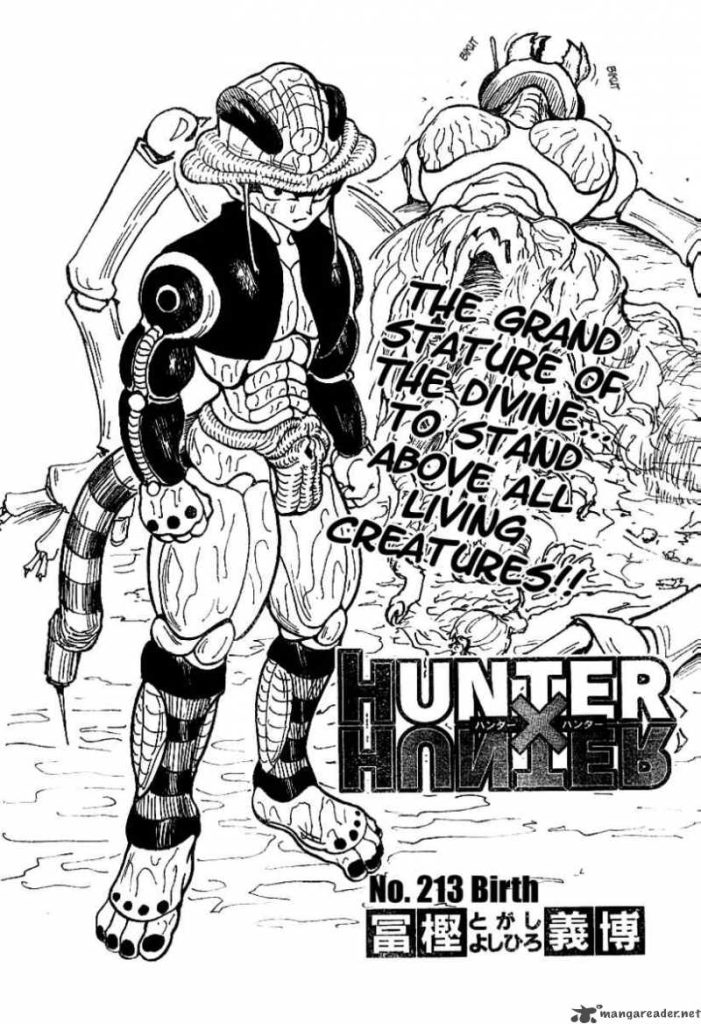
With the stage set, plans are set into motion.
The Boring Parts
Remember in Part 1 when I said that I had issues with the Chimera Ant Storyline’s pacing? Well, here is the main stretch of the story that I find incredibly dull. There are cool moments interspersed here and there, with a particular highlight being the foreshadowing of Gon’s fall from grace as he embraces his frustrations. But here is where shounen plot deconstruction works against itself. This entire stretch of the arc, easily a fourth or greater of the arc’s total length, is just spent meandering and setting up even more pointless information. Most shounen character plans are designed with enough specifics and tactics to create tension and stakes, but are still vague enough so that the proper character action can get going. There is a calm before the storm, but now that calm is excessive. Here, Togashi opts to make the plans tedious, almost like a real battle plan.
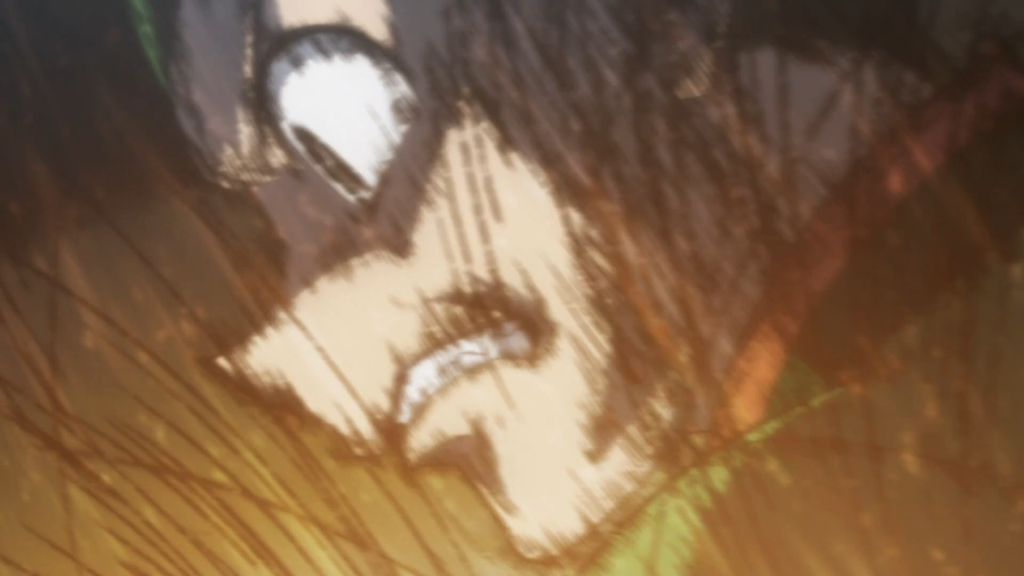
Realism doesn’t always work in fiction though.
While the effort is appreciated, the slow crawl of this section halts all narrative progression for the sake of introducing new characters, throwing in more fights with jobber Ants (including the annoying Cheetu character) and splitting up the characters, who work best off each other. Most of our characters’ journeys from here on are pretty much just a scavenger hunt to line up the less interesting pieces of the puzzle: Gon befriends a Chameleon Ant for the mission, Killua becomes buddies with an Octopus Ant named Ikalgo, and everyone else has minor battles with half-relevant characters.
The only parts of this plot that make any sort of impact are the interactions between Meruem the King Ant, his Royal Guards, and his human hostage Komugi. These interactions are fantastic on a character and thematic level, but there is very little progression here beyond us learning what the Ants’ plan is (a human genocide within the country they are holed up in). Outside of this, interesting plot events are glossed over such as the infiltration of Meruem’s palace by the previously established Palm character and Netero’s whereabouts. It’s kind of relevant to see what our most powerful character is doing, I think…
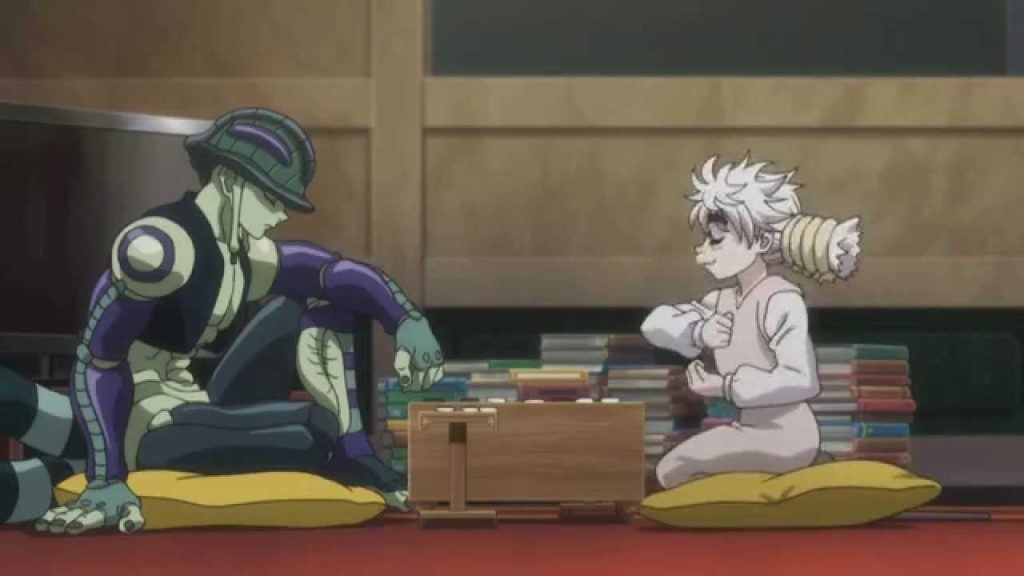
Again, on a character basis, this section of the arc does well, but there’s unnecessary padding that makes re-reads or rewatches a slog…I’ll even go so far to say that we didn’t need to see the Phantom Troupe fight Ants in a separate one-off area. Sure, building anticipation and methodically planning out strategic advantages for our characters makes sense: they need all the help they can get in their fight against the King, but the execution was bloated and meandering at best.
Thankfully, the ending makes all the waiting worth it.
An Explosive Ending:
If the beginning of the arc is perfect, and the middle is average, then the ending of the arc is godly. The final battle is a staple in fiction: our heroes, confident and invigorated, pull up to the antagonists to scrap for the stake of the world.
But HxH never really does that. With the more tactical nature of its fights and the focus on character relationships, this final battle flips the final battle idea on its head, emphasizing the futility of these fights and depriving our heroes of wins and payoffs. A single lousy punch landed against an Ant is a triumph, every “badass” moment comes with grave consequences, Gon and Meruem (our two central characters in this story) never even exchange a word. This part of the arc takes every possible gratification a viewer can have when reading a climax and leaves them feeling hollow and guilty. The plot events here are relatively simple: the Hunters raid Meruem’s palace with the plan of defeating him, as well as getting their help in “fixing” Kite so that he may become a normal person again…although the reader knows he’s already dead.
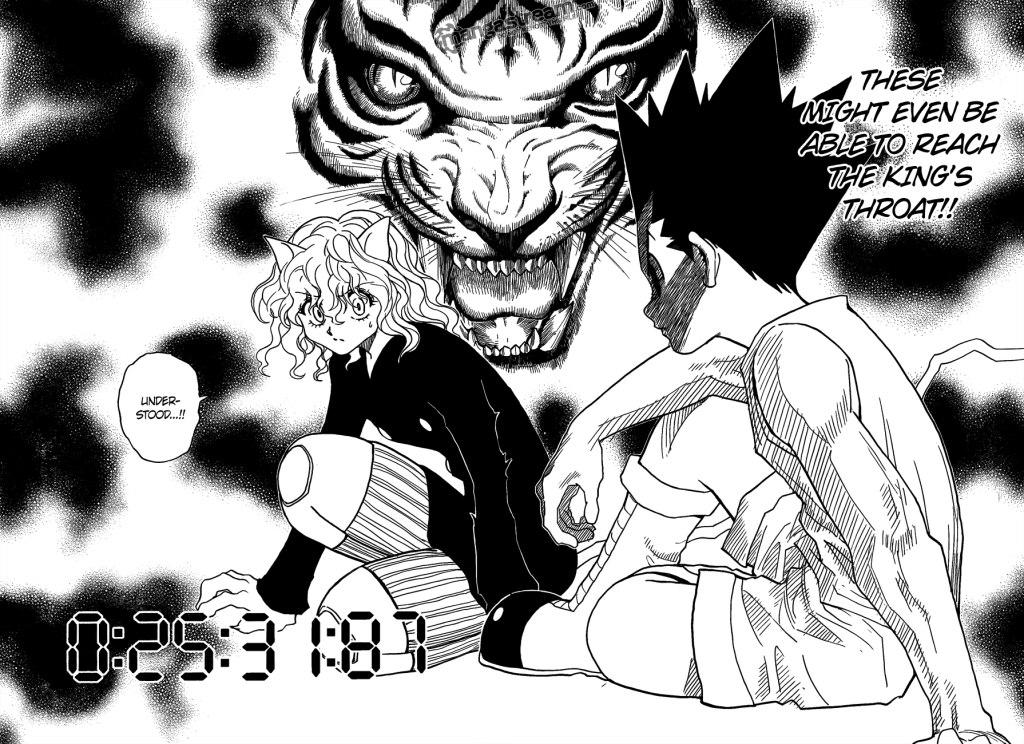
The biggest part of a shounen climax are the hours-long fights, spanning episodes and chapters with powerups, clever moves and emotional victories, but Togashi refuses to give the reader that here. Through (admittedly forced) narration, many of these fights are revealed to take place in the span of a few minutes, with our protagonists barely causing the Ants any actual damage in their respective fights. While the Nen system of HxH is complex and requires a high IQ from both the reader and the characters to fully understand, many of the wild tactics from our characters here never work. A triumphant event like Morel trapping Royal Guard Pouf is robbed simply because Pouf’s raw power counters his perfectly. Knuckle’s APR ability, perfect for disarming an Ant as strong as Youpi, doesn’t amount to anything when he fears for the death of his comrades and cancels it. Gon rarely does anything but wait angrily. Meruem hardly uses any Nen with his fight against Netero, barely feeling pain as he dismembers the world’s strongest man over and over again. Their fight, as wonderfully choreographed and characterized it is, is super short and anticlimactic, ending when Netero commits suicide to drop a NUKE on Meruem…only for him to get back up like nothing happened a few chapters later.
See what I mean about consequences? Every character that is weak gets worked to the bone, either dying or realizing that this whole mission was destined to fail. Every time we get a happy moment, it’s met with a sobering realization that it probably didn’t matter: did you know that when Killua first used Godspeed against Youpi he caused no real damage? When Gon enters his legendary revenge match with Pitou, his victory means nothing: Kite will never be alive again, and he ended his own life just for personal satisfaction.
Of course, the plot’s events stray from just the fights: a standout moment comes when Meruem, the invincible and godlike monster, finally develops feelings of sympathy for Komugi and humans. The greatest moments of this plot come from his own actions: his return to the palace to look for her after he gets blown up, his sudden realization that the poison from the bomb will slowly kill him, his final game of Gungi with Komugi before he dies. This arc’s plot turns what is portrayed as a grand battle at first into a real war: people die, characters are traumatized, and at the end of the day, the lines between good and evil were blurred. By following the plot’s last events from Meruem’s perspective as our heroes retreat, battered and defeated by this grand battle, we aren’t left with a grand finale, our protagonists celebrating, Gon finding his dad. It’s empty and hollow. As the ants die one by one from the poison released from Netero’s bomb, you can’t help but feel guilty. Yes, they were monsters that needed to be stopped, but was there a chance our human characters were just as bad as the ants?
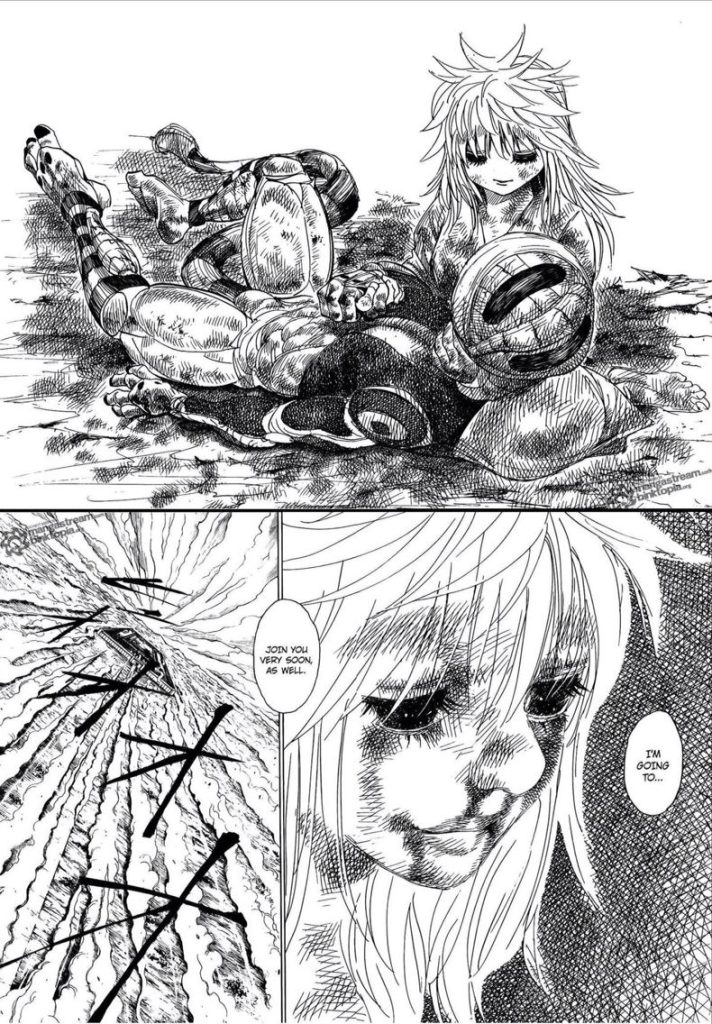
That very question drives the narrative of this arc, the exact opposite of how a typical shounen plot works. It’s a genius subversion of the storytelling that most stories of this genre tell. It focuses failure and flawed morality instead of the cool, badass powerups and typical asspulls. This is a huge reason why the Chimera Ant Storyline works so well…but I think it shines in so many more places, especially in its characters. Join me next week as I begin to analyze the characters of the arc, starting with the “good guys” of this arc. There is a lot of content that I jumped over for the larger narrative that I will cover in the future…so I hope I see you there!
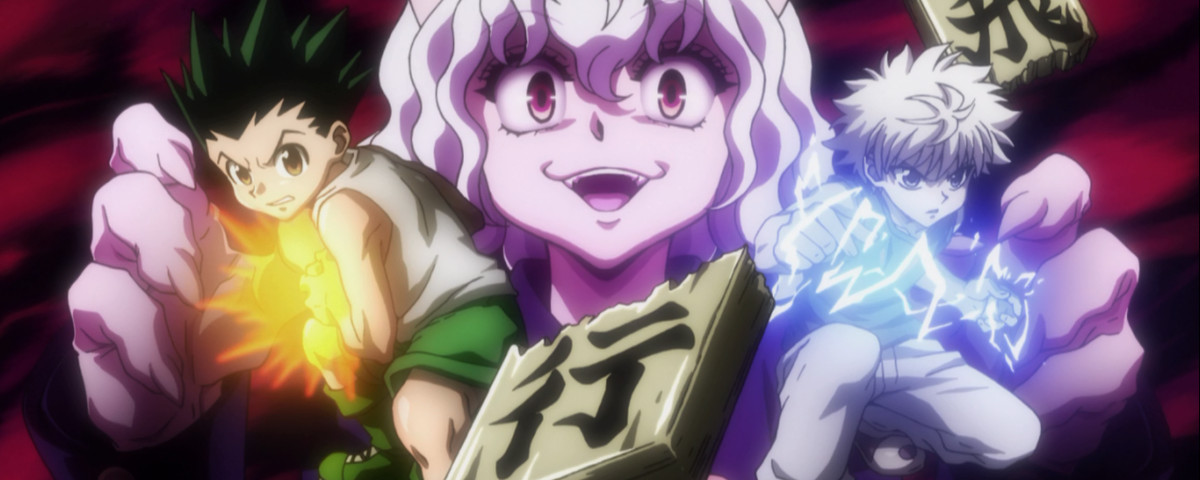
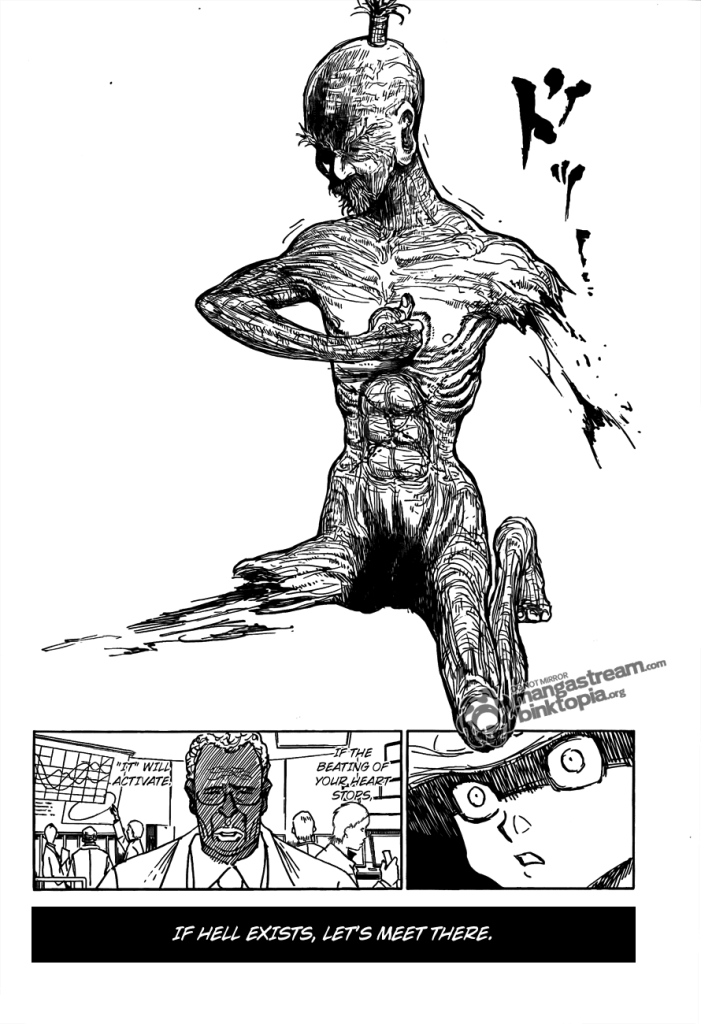
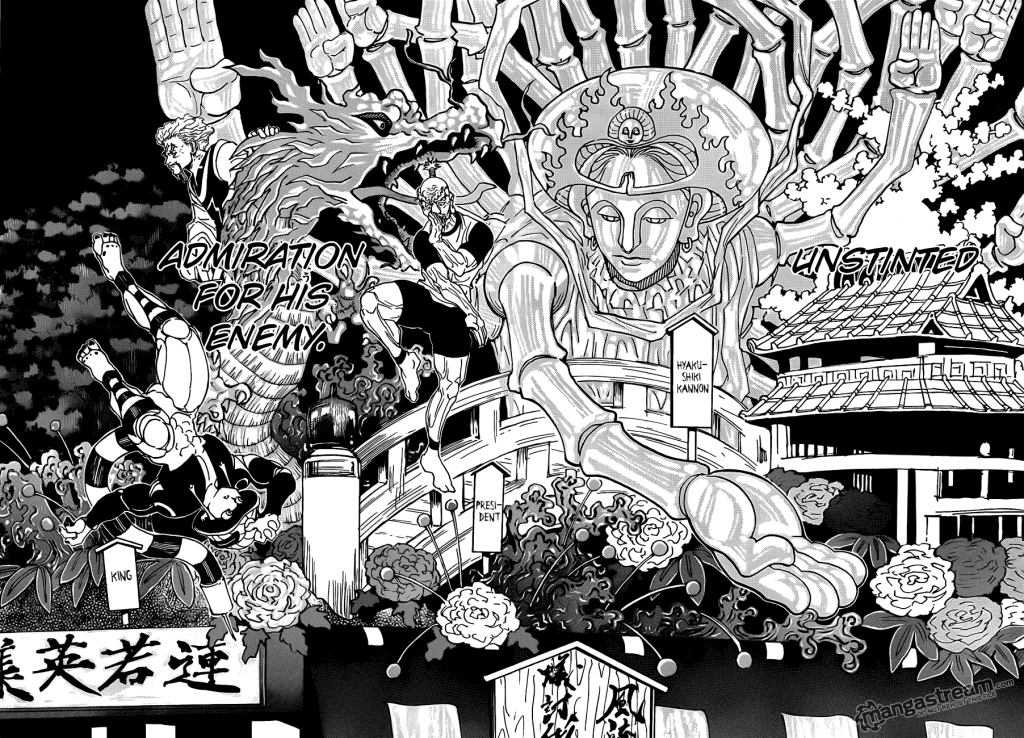


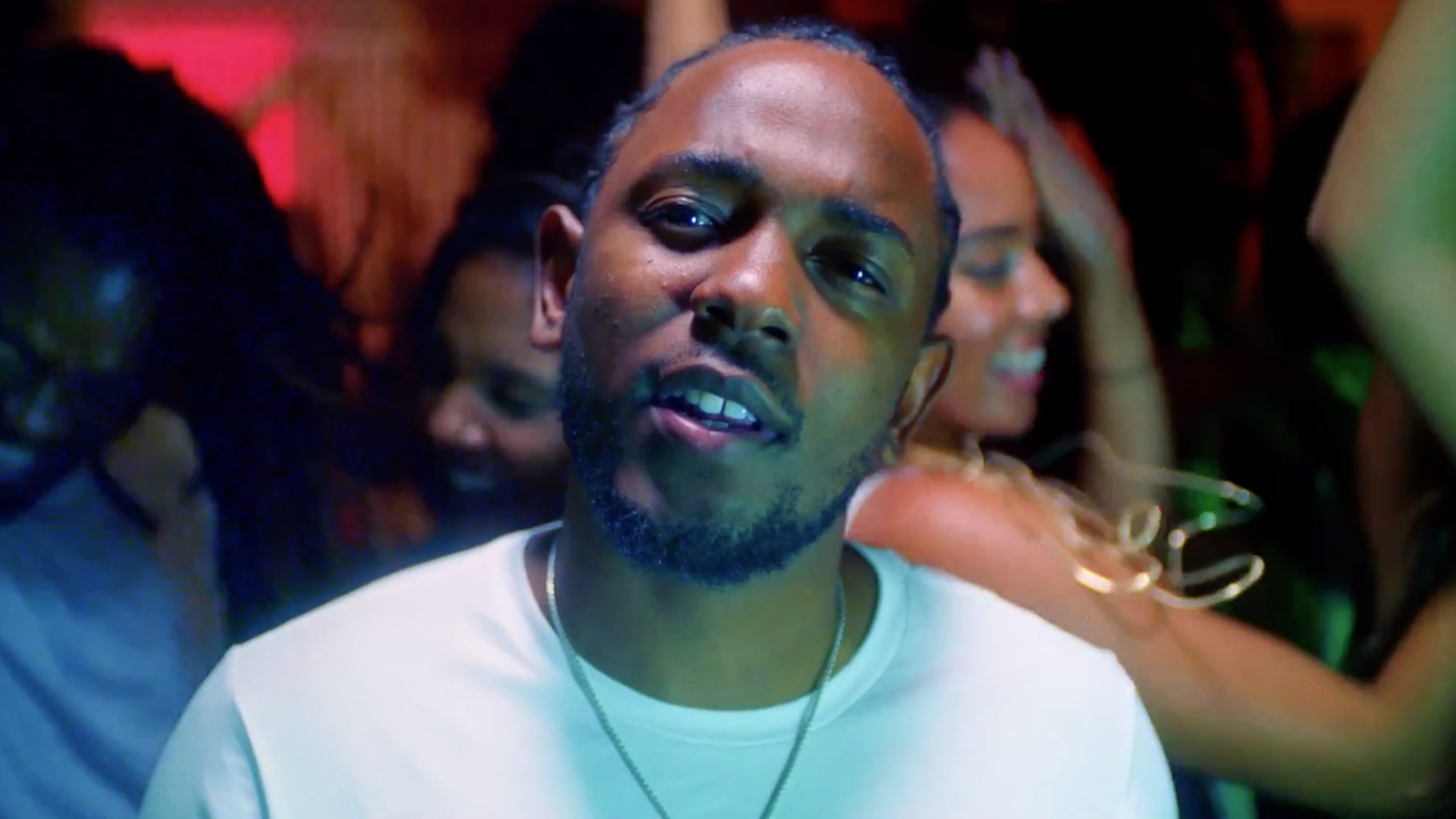
mekar55 : https://www.xata.org/